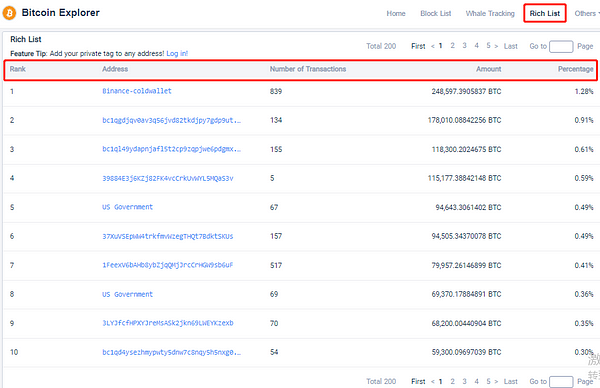The third largest Bitcoin whale surfaced, suspected Gemini? How to track it?
Bitcoin whale refer to addresses with a large amount of Bitcoin (holding at least 1000 BTC), and they play an important role in the Bitcoin market. These addresses are usually held by individuals, investors, exchanges or other institutions. They amass wealth by buying large amounts of Bitcoin and exerting influence in the market.

In fact, except for some whale addresses that have been counted by real names, many bitcoin whales are unwilling to disclose their real identities publicly. But since every transaction they make will have a great impact on the market, we can track the addresses of these whales to grasp their dynamics.
How to explore the Bitcoin whales?
On the Tokenview whale ranking list, you can get the address information of the head whale.
Open the Bitcoin block explorer https://btc.tokenview.io/en, enter the Bitcoin explorer interface, and select【Rich List】 in the top navigation bar.

Enter the 【Rich List】interface, and then you can view the rich list of Bitcoin.

According to the existing on-chain information, the current number one Bitcoin holder address is Binance-coldwallet, and the fifth and eighth addresses both belong to the US government.
Previously, we also introduced the news that the Tether became the 11th largest Bitcoin holder in the world. But recently, another mysterious Bitcoin whale surfaced. An anonymous wallet address has accumulated more than worth $3 billion BTC in the past 3 months, becoming the third largest Bitcoin holder.
Find the third largest Bitcoin address: bc1ql49ydapnjafl5t2cp9zqpjwe6pdgmxy98859v2
According to Tokenview data, the address currently has accumulated 118,300 BTC, which is worth more than $3 billion based on current market prices. While the identity of the owner remains unclear, current sources point to Gemini and BlackRock.

How to track the Bitcoin whales?
Whales tend to hide their true identities and move funds covertly. But we can still find potential crypto whales and track their activities through certain signs. What matters most is how much the whale’s address holds, how often it moves, and where the funds go.
Tokenview address tracking is designed to make it easier for users to track wallet addresses of interest. Once the balance of the address changes, a notification will be triggered, allowing you to track the activities of the monitored wallet in real time.
It is very simple to use Tokenview [Address Tracking] function.
Step 1 Creat a Tokenview Account
After you register and log into your Tokenview account, you will enter the main interface.
Register an account:
https://services.tokenview.io/cn/login?isregiter=true&from=hashnode

Step 2:Set Webhook URL
After completing step 1, you will get an APIkey. Now click [Address Tracking] >> [Settings], and add the URL for receiving information. If you do not set it or set it incorrectly, you will not be able to receive the push balance change notification.

Step 3:Add tracking address
Select [Tracked Coin]<[BTC] , and enter the address of the whale. Finally, click [ADD] to complete address tracking.
Currently, the tokens supported by Tokenview address tracking API are: BTC, ETH (including all ERC20 tokens), TRX (including all TRC20 tokens), LTC, BCH, DOGE, ETC, DASH and RVN, etc., and addresses can be uploaded in batches.

Step 4:Get whale transaction information
Once the balance of the Bitcoin whale address changes, Tokenview address tracking will remind through Webhook, and users can get instant notification information.
Closing thoughts
Bitcoin whale represent wealth and strength in the Bitcoin market. The holdings of these whales play an important role in the stability and development of the entire Bitcoin market. Although we don’t know who the specific holders of these addresses are, they undoubtedly play an important role in the Bitcoin world. By continuously tracking the movements of these whales, we can better understand the development and changes of the Bitcoin market.
Now, it’s time to register : https://services.tokenview.io/cn/login?isregiter=true&from=hashnode